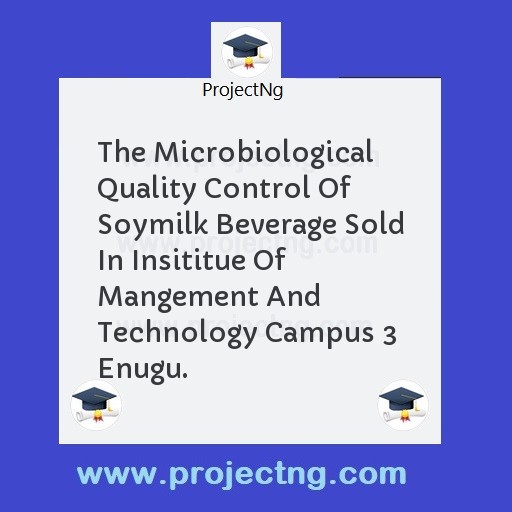The Microbiological Quality Control Of Soymilk Beverage Sold In Insititue Of Mangement And Technology Campus 3 Enugu.
Science Lab Technology Project Topics
Get the Complete Project Materials Now! »
THE MICROBIOLOGICAL QUALITY CONTROL OF SOYMILK BEVERAGE SOLD IN INSITITUE OF MANGEMENT AND TECHNOLOGY CAMPUS 3 ENUGU.
ABSTRACT
The study is aimed at evaluating the microbiological quality control of soymilk beverage sold in I.M.T campus 3 Enugu. The soymilk samples were collected randomly from all the soymilk hawkers in campus 3 I.M.T Enugu. 30 soymilk samples were collected and used for the study. All the sample were freshly prepared, serial dilution of the soymilk samples was carried out. The sample were cultured using the streaking method on nutrient and Macconkey agar media Gram staining and microscopic examination was carried out to identify the organism. Biochemical test were finally carried out to confirm the implicated organism. The bacteria implicated in this study were staphylococcus sp and escherichia coli.
TABLE OF CONTENTS
Title page
Contents
Certification
Dedication
Acknowledgement
Abstract
Table of content
CHAPTER ONE
1.0 INTRODUCTION
CHAPTER TWO
2.0 literature review
2.1 Processing of soybeans
2.2 Nutritional value of
2.3 Soymilk and the human health
2.4 Spoilage of foods
2.4.1 Microbial activities
2.4.2 Food pests
CHAPTER THREE
3.0 Material and method
3.1 Materials
3.2 Methodology
3.2.1 Microbiological examination
3.2.2 Gram staining
3.2.3 Biochemical test for identification
CHAPTER FOUR
4.0 Result
CHAPTER FIVE
5.0 Discussion
5.1 Conclusion
5.2 Recommendation
REFERENCES
APPENDIX
LIST OF TABLE
TABLE 1:
The colony morphology, gram reaction and optimum growth temperature of the isolates.
TABLE 2
Biochemical test of Bacterial isolates in the samples
LIST OF FIGURES
FIG 1
Sketch of process flow diagram for extraction of soymilk
Fig 2:
Staphylococcus specie as found on nutrient agar and macconkey agar
Fig 3:
Escherichia coli as found on macconkey agar.
CHAPTER ONE
INTRODUCTION
The three basic needs of man are food shelter and clothing but food has been proved to be the most important. Food has been defined as that which can be eaten to nourish the body. Since the economic situation is getting worse day by day, it becomes imperative that an alternative soymilk be provided to improve nutrition status.
Soybeans (Glycine max) is a member of the family legminosae, sub family papilnonaceae (Howell and Caldwell, 1972) Ezedinma F.O.C 1964) it is an annual summer legume be4ing that it is found in the hairy pods of an erect bushy legume native to Asta and have been reported to have originated from eastern and where used as food as long as before the existence of written record. It is highly proteinous in that it contains a large proportion of assailable protein, have carbohydrate having no starch at all. The protein of soybeans are glycinun, phaseolin, and legumlin are equally good source of B- comple vitamins and minerals (James et al 1992). They are also known to contain best blance of essential ammoniac’s and that is why it is usually referred to as the miracle legume or the poor mans meats”.
SOYBEAN PRODUCTION
Originally confined to the temperate zone is no spreading rapidly into tropic particularly in Brazil and other parts of south American in India and in the far East Inspite of being one of the earliest filed crops, soybeans was introduced into Nigeria shows that Benue state and Kogi state is the most important soybeans producing are in the country. In Nigeria, nearly all of the soybeans production estimated at 30,000 tons is for human consumption and
Be the First to Share On Social

Enjoying our content?
Don't miss out on new videos! Subscribe to our YouTube channel for more awesome content.
Subscribe Now!













